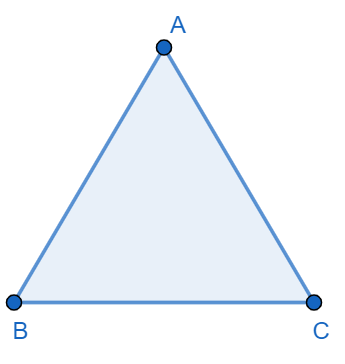Question
Question: The angles of a triangle are in AP and the number of grades in the least is to the number of radians...
The angles of a triangle are in AP and the number of grades in the least is to the number of radians in the greatest as 40:π; find the angles in degrees.
Solution
Hint: We will use the concept of AP that B=2(A+C) where A,B and C are consecutive terms of the AP. Let us assume the angle B=x then from this we get angle A as A=x−d and angle C as C=x+d where d is a common difference.
Complete step-by-step answer:
We will also use some conversions as below in our question. To convert degree into grade, we get
((x−d)×90100)g also to convert the angle into radian form degree, we multiply the value in degree with 180π.
It is given in the question that the angles of a triangle are in AP and the number of grades in the least is to the number of radians in the greatest as 40:π, then we have to find angles of the triangle in degree.
Let us assume that ABC is a triangle.

We know that A,B,C are in AP and which means there is a constant common difference of ‘d’ respectively. Let us assume the angle B=x then from this we get angle A as A=x−d and angle C as C=x+d where d is a common difference.
We know that sum of all the three angles in a triangle is 180 degree, therefore,
A+B+C=180∘
Putting the above values of A,B,C in this equation, we get,
(x−d)+x+(x+d)=180∘
Solving further, we get,
3x=180∘
x=3180∘=60∘
Thus angle A=(60−d)∘, B=60∘ and C=(60+d)∘.
Now, least angle is angle A which is (60−d)∘, so we will convert it into grade using the relation ((x−d)×90100)g. Thus angle A=((60−d)×90100)g=(60−d)×910.
Also, angle C=(60+d)∘ is the greatest angle and we will convert it into radians by multiplying the value in degree with 180π, that is we get
C=(60+d)×180π
It is given that the ratio of Ag:Cr=40:π , we get
(60+d)180π(60−d)910=π40
On cancelling the similar terms on both the side, we get
⇒(60+d)×9(60−d)×180=14
Solving further, we get,
⇒(60+d)(60−d)=51
On cross multiplying, we get
⇒5×(60−d)=(60+d)
⇒300−5d=60+d
Transposing the similar terms on same side, we get
⇒6d=240
Therefore, simplifying we get
⇒d=40
Now, on putting the value of d in the Angles equation, we get angle A=60−d=60−40=20∘, angle B as B=60∘ and angle C as C=60+d=60+40=100∘.
Thus, the angles of triangle in degree are 20∘,60∘and 100∘ respectively.
Note: Many times students directly skip this type of questions in exams because they do not know how to convert a degree into grades and radians and we cannot solve this question without converting the degree into grades and radians. Also, the possibility of error is higher in the last step when the two ratios are compared because it is quite a big calculation thus it is recommended to do calculation step by step.
